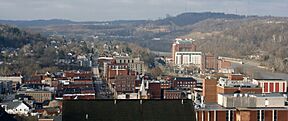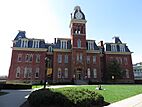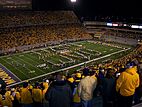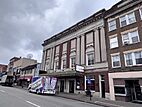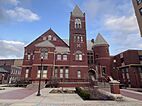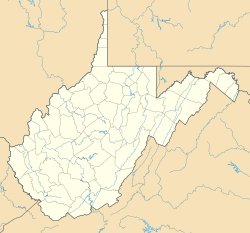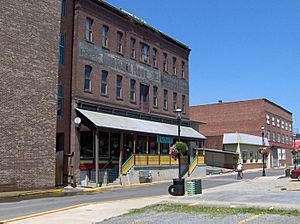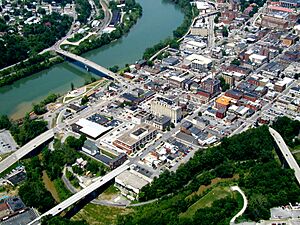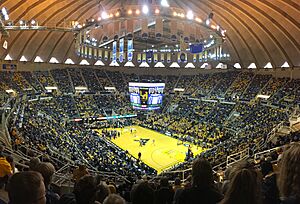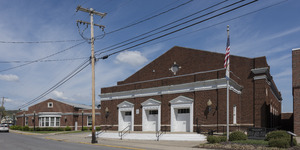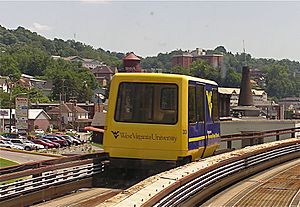Morgantown, West Virginia facts for kids
Quick facts for kids
Morgantown, West Virginia
|
|||||
|---|---|---|---|---|---|
|
Milan Puskar Stadium
Metropolitan Theatre
|
|||||
|
|||||
| Motto(s): | |||||

Location of Morgantown in Monongalia County, West Virginia.
|
|||||
| Country | |||||
| State | |||||
| County | Monongalia | ||||
| Settled | 1772 | ||||
| Chartered | 1785 | ||||
| Incorporated | 1838 | ||||
| Founded by | Zackquill Morgan | ||||
| Named for | Zackquill Morgan | ||||
| Government | |||||
| • Type | Council–manager | ||||
| Area | |||||
| • City | 10.64 sq mi (27.55 km2) | ||||
| • Land | 10.19 sq mi (26.40 km2) | ||||
| • Water | 0.45 sq mi (1.16 km2) 4.24% | ||||
| Elevation | 1,161 ft (354 m) | ||||
| Population
(2020)
|
|||||
| • City | 30,347 | ||||
| • Density | 2,997.35/sq mi (1,157.25/km2) | ||||
| • Urban | 77,620 (US: 366th) | ||||
| • Metro | 140,038 (US: 300th) | ||||
| Time zone | UTC−5 (EST) | ||||
| • Summer (DST) | UTC−4 (EDT) | ||||
| ZIP codes |
26501, 26505, 26508
|
||||
| Area code | 304, 681 | ||||
| FIPS code | 54-55756 | ||||
| GNIS feature ID | 1555161 | ||||
| Website | www.morgantownwv.gov | ||||
Morgantown is a city in West Virginia, United States. It is the main city of Monongalia County. Morgantown is located along the Monongahela River. It is the most populated city in North Central West Virginia. It is also the third-most populated city in the whole state.
Morgantown is best known as the home of West Virginia University. In 2020, about 30,347 people lived in the city. Morgantown is the center of a larger area called the Morgantown metropolitan area. This area had about 138,176 people in 2020.
Contents
History of Morgantown
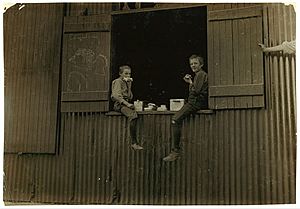
The history of Morgantown is linked to the fight between the British and French for this land. Before 1763, the area was often fought over. Both white settlers and Native Americans lived there. British and French soldiers also fought for control. The Treaty of Paris in 1763 gave the land to the British. But fighting with Native Americans continued until the American Revolutionary War began in 1775.
Zackquill Morgan and David Morgan came to the area around 1767. They were sons of Morgan Morgan. Other people, like Thomas Decker, had tried to settle there earlier. Zackquill and David lived there for a few years. They built Fort Morgan in what is now Downtown Morgantown in 1772. Many forts were built in the area during this time to protect settlers.
Zackquill Morgan made his home near what is now Fayette Street in 1772. He fought in both the French and Indian War and the American Revolutionary War. He became a colonel. After the wars, Colonel Morgan had his land measured and divided into streets and lots in 1783. In 1785, the Virginia General Assembly officially set aside 50 acres for "Morgan's Town."
On February 3, 1838, Morgantown became an official city. It had about 700 people then. The town was called Morgantown, Virginia. Later, on June 20, 1863, Morgantown became part of the new state of West Virginia.
Some old buildings still stand in Morgantown today. The Old Stone House was built in 1795. The John Rogers family home was built in 1840.
In the 1970s, an experimental driverless transit system was built in the city. It was called the Morgantown Personal Rapid Transit (PRT). It has been used since 1975. Students at West Virginia University use it to travel between campuses.
Geography and Climate
Morgantown is about 75 miles south of Pittsburgh, Pennsylvania. It is also about 208 miles west-northwest of Washington, D.C. The city is just south of the Mason–Dixon line.
The city covers about 10.62 square miles. Most of this is land, and a small part is water.
City Neighborhoods
Morgantown has many neighborhoods. Some of these used to be separate towns. They became part of Morgantown as the city grew. Some neighborhoods include First Ward, Woodburn, South Park, and Suncrest. About 30,000 people live in Morgantown permanently. The city also hosts about 30,000 students from West Virginia University.
Sunnyside is an older neighborhood near the university's downtown campus. It is known for student housing. The city and university are working together to improve this area.
Woodburn used to be farmland. It grew quickly in the early 1900s. Many tinsmiths from Wales moved there to work in a tinplate mill. A trolley line once connected Woodburn to downtown. The Welsh community kept their language and traditions alive for many years.
Sabraton is in the southeastern part of Morgantown. It was once a coal town. It was also home to a manufacturing plant. Sabraton has a park called Marilla Park.
Hills and Rivers
Morgantown is in the Appalachian Region. The city has many hills. Some parts are over 1,200 feet high. The highest point is Sky Rock in Dorsey Knob Park, at 1,398 feet. The lowest point is along the Monongahela River, at 800 feet. The area around Morgantown is mountainous. Coopers Rock State Forest, east of Morgantown, has elevations between 2,000 and 2,400 feet.
Weather in Morgantown
Morgantown has four distinct seasons. Winters are cool to cold. The average temperature in January is 32.0°F. It snows about 27.6 inches each year. Summers are hot and humid. The average temperature in July is 74.1°F. It often gets above 90°F in the summer. The city gets a good amount of rain, with May through July being the wettest months. The coldest temperature ever recorded was −25°F in February 1899. The hottest was 105°F in August 1893.
| Climate data for Morgantown, West Virginia (Morgantown Municipal Airport), 1991–2020 normals, extremes 1872–present | |||||||||||||
|---|---|---|---|---|---|---|---|---|---|---|---|---|---|
| Month | Jan | Feb | Mar | Apr | May | Jun | Jul | Aug | Sep | Oct | Nov | Dec | Year |
| Record high °F (°C) | 79 (26) |
80 (27) |
87 (31) |
93 (34) |
95 (35) |
99 (37) |
103 (39) |
105 (41) |
102 (39) |
94 (34) |
83 (28) |
77 (25) |
105 (41) |
| Mean maximum °F (°C) | 65.7 (18.7) |
67.0 (19.4) |
75.4 (24.1) |
83.5 (28.6) |
88.0 (31.1) |
90.8 (32.7) |
92.5 (33.6) |
91.4 (33.0) |
89.2 (31.8) |
82.3 (27.9) |
74.7 (23.7) |
66.1 (18.9) |
93.3 (34.1) |
| Mean daily maximum °F (°C) | 40.1 (4.5) |
43.7 (6.5) |
52.6 (11.4) |
65.2 (18.4) |
73.6 (23.1) |
80.9 (27.2) |
84.4 (29.1) |
83.1 (28.4) |
77.1 (25.1) |
65.9 (18.8) |
54.1 (12.3) |
44.3 (6.8) |
63.8 (17.7) |
| Daily mean °F (°C) | 32.0 (0.0) |
34.8 (1.6) |
42.6 (5.9) |
53.8 (12.1) |
62.6 (17.0) |
70.3 (21.3) |
74.1 (23.4) |
72.8 (22.7) |
66.5 (19.2) |
55.3 (12.9) |
44.9 (7.2) |
36.4 (2.4) |
53.8 (12.1) |
| Mean daily minimum °F (°C) | 24.0 (−4.4) |
25.8 (−3.4) |
32.6 (0.3) |
42.4 (5.8) |
51.5 (10.8) |
59.7 (15.4) |
63.8 (17.7) |
62.5 (16.9) |
55.9 (13.3) |
44.7 (7.1) |
35.8 (2.1) |
28.6 (−1.9) |
43.9 (6.6) |
| Mean minimum °F (°C) | 2.6 (−16.3) |
7.0 (−13.9) |
13.8 (−10.1) |
26.1 (−3.3) |
35.5 (1.9) |
45.3 (7.4) |
52.7 (11.5) |
51.9 (11.1) |
41.9 (5.5) |
29.9 (−1.2) |
19.8 (−6.8) |
11.6 (−11.3) |
0.3 (−17.6) |
| Record low °F (°C) | −20 (−29) |
−25 (−32) |
−4 (−20) |
6 (−14) |
25 (−4) |
30 (−1) |
40 (4) |
38 (3) |
30 (−1) |
15 (−9) |
−1 (−18) |
−16 (−27) |
−25 (−32) |
| Average precipitation inches (mm) | 3.12 (79) |
2.81 (71) |
3.65 (93) |
3.87 (98) |
4.33 (110) |
4.07 (103) |
4.93 (125) |
3.65 (93) |
3.41 (87) |
3.09 (78) |
3.02 (77) |
3.20 (81) |
43.15 (1,096) |
| Average snowfall inches (cm) | 9.1 (23) |
5.5 (14) |
7.0 (18) |
1.0 (2.5) |
0.0 (0.0) |
0.0 (0.0) |
0.0 (0.0) |
0.0 (0.0) |
0.0 (0.0) |
0.1 (0.25) |
1.1 (2.8) |
3.8 (9.7) |
27.6 (70) |
| Average precipitation days (≥ 0.01 in) | 15.5 | 13.0 | 14.4 | 14.1 | 14.7 | 13.1 | 12.4 | 10.5 | 10.3 | 11.4 | 11.7 | 13.9 | 155.0 |
| Average snowy days (≥ 0.1 in) | 6.1 | 4.3 | 3.3 | 0.3 | 0.0 | 0.0 | 0.0 | 0.0 | 0.0 | 0.1 | 1.1 | 3.5 | 18.8 |
| Source: NOAA (snow 1981–2010) | |||||||||||||
People of Morgantown
| Historical population | |||
|---|---|---|---|
| Census | Pop. | %± | |
| 1860 | 741 | — | |
| 1870 | 797 | 7.6% | |
| 1880 | 745 | −6.5% | |
| 1890 | 1,011 | 35.7% | |
| 1900 | 1,895 | 87.4% | |
| 1910 | 9,150 | 382.8% | |
| 1920 | 12,127 | 32.5% | |
| 1930 | 16,186 | 33.5% | |
| 1940 | 16,655 | 2.9% | |
| 1950 | 25,525 | 53.3% | |
| 1960 | 22,487 | −11.9% | |
| 1970 | 29,431 | 30.9% | |
| 1980 | 27,605 | −6.2% | |
| 1990 | 25,879 | −6.3% | |
| 2000 | 26,809 | 3.6% | |
| 2010 | 29,660 | 10.6% | |
| 2020 | 30,347 | 2.3% | |
| U.S. Decennial Census | |||
In 2010, Morgantown and nearby Preston County were recognized as a metropolitan area. This means they are a large city area. In 2020, the population of Morgantown was 30,347.
West Virginia University takes up a large part of the city. In fall 2012, the university added about 29,707 students to the city's population. Morgantown has had some of the lowest unemployment rates in the United States. This means many people have jobs there.
2020 Census Information
In 2020, there were 30,347 people and 11,673 households in Morgantown. Most people (83%) were White. About 4.6% were African American, and 3.7% were Asian. About 4.1% of the population was Hispanic or Latino.
The average age in the city was 24.4 years. This is much younger than the state average of 42.8 years. Many young people live in Morgantown because of the university.
Fun Things to Do

Arts and Culture
The Metropolitan Theatre is a main spot for shows in Morgantown. The Monongalia Arts Center helps with art, music, and writing in the city. You can also visit the West Virginia University Art Museum and the Morgantown History Museum.
Parks and Recreation
The Core Arboretum is owned by West Virginia University. It has old forests and walking trails. There are also lawns with special trees. Other parks in Morgantown include Hazel Ruby McQuain Riverfront Park. There are also walking and biking trails like the Caperton and Deckers Creek Rail-Trails.
For sports, you can visit Milan Puskar Stadium and WVU Coliseum. These are where the West Virginia Mountaineers football and basketball teams play.
Dorsey Knob is a mountain at the southern edge of Morgantown. It is 1,398 feet high.
Sports Teams and Events
The West Virginia Black Bears are a summer baseball team in Morgantown. They play at the Monongalia County Ballpark.
The first Morgantown Marathon was held in 2015. It is a 26.2-mile race that goes through the city's neighborhoods. It is known for its hills. Runners can use their times from this marathon to qualify for the Boston Marathon. There is also a half-marathon and an 8k race.
Education in Morgantown
West Virginia University
West Virginia University (WVU) is a large public university. It was started in 1867. The university spends about $1.2 billion each year. It also gets $150 million for research projects.
In fall 2021, 28,267 students were enrolled at WVU. Students came from all 55 counties in West Virginia. They also came from 49 states and 112 countries.
- About 46% of students are from West Virginia.
- About 53% of students are female, and 47% are male.
- About 18% of students are minorities.
WVU offers many different programs. There are 13 colleges and schools. They offer over 350 degrees. These include bachelor's, master's, and doctoral degrees.
Public Schools
Morgantown's public schools are part of Monongalia County Schools. There are several elementary schools, including Suncrest Elementary. There are four middle schools, such as Mountaineer Middle. The city has two high schools: University High School (the Hawks) and Morgantown High School (the Mohigans). The Mohigans mascot name comes from a mix of "Morgantown High Annual."
In 2005, Monongalia County Schools had 897 teachers and 490 support staff. There were 10,076 students. Some schools have won awards for their high achievements. For example, Suncrest Middle became a National Blue Ribbon School in 2004.
Private Schools
Morgantown has several private schools. Saint Francis de Sales is a Catholic elementary school. It started before 1915. It moved to a new building in 1918. Its mascot is the Trojan.
Other private schools include Morgantown Christian Academy and Trinity Christian School. There is also the Morgantown Learning Academy.
Early Schools
Morgantown had informal schools from its early days. In 1803, a public school was started. Students paid tuition to attend. In 1814, Monongalia Academy was created. It was the county's first public school for boys. It was like a modern-day high school. The Academy closed in 1867. Its land was given to help start West Virginia University.
In 1831, the Morgantown Female Academy was created for girls. It later became known as the Methodist Academy. Another school, the Woodburn Female Seminary, also existed. Its assets were also given to the future university.
After West Virginia became a state in 1863, a public school system was created. It included education for African-American children. However, there were separate schools for white and African-American children.
Media and News
Newspapers
Morgantown has two newspapers. The Dominion Post is a daily newspaper. The Daily Athenaeum is run by students at the university. It is published on weekdays during classes and is free.
There are also free local papers like the Post Extra and the Morgantown Times. They have some local news and many advertisements.
Television and Radio
Morgantown is part of the Pittsburgh television market. But stations from nearby Clarksburg and Fairmont also cover Morgantown. Cable TV providers offer channels from both areas.
Morgantown has several radio stations. They play different types of music and news. Some stations include WCLG (rock), WAJR (news/talk), and WVAQ (pop). There is also a college radio station, WWVU-FM, run by West Virginia University.
City Services
Transportation
Public Transportation
Most of Morgantown can be reached by the Mountain Line Transit Authority bus system. Buses run Monday through Saturday. There is limited service on Sundays during the WVU school year. The Grey Line bus runs every day between Clarksburg, West Virginia and Pittsburgh International Airport.
Morgantown also has the Morgantown Personal Rapid Transit (PRT) system. This system has five stations. It covers about 8.65 miles.
Airports
Morgantown Municipal Airport is one of West Virginia's commercial airports. It is about 3 miles northeast of downtown. North Central West Virginia Airport is about 35 miles away. Pittsburgh International Airport is about 80 miles away.
Rail and River
The only active train line near Morgantown is used for shipping coal. It also serves local chemical industries.
Morgantown uses the Monongahela River a lot for shipping coal and other goods. The river can be used by boats from Pittsburgh, past Morgantown, up to Fairmont. The Morgantown Lock and Dam helps keep the river at a good level for shipping.
Main Roads
Major roads that go through Morgantown include:
 Interstate 79
Interstate 79 Interstate 68
Interstate 68 U.S. Highway 19
U.S. Highway 19 U.S. Highway 119
U.S. Highway 119 West Virginia Route 7
West Virginia Route 7 West Virginia Route 705
West Virginia Route 705
Utilities
Electricity in Morgantown is provided by Mon Power. Natural gas comes from Dominion Resources. Water and sewage services are handled by the Morgantown Utility Board.
Cable television and cable Internet are offered by Comcast Communications. Phone and internet services are also available from Frontier Communications and Breezeline.
Trash pickup is provided by Republic Services. The City of Morgantown has a weekly recycling program. This is part of the city's Clean Community Concept.
Famous People from Morgantown
- Earl E. Anderson, a high-ranking General in the U.S. Marines
- Thomas Bennett, a U.S. Army medic who received the Medal of Honor
- Jeff Bowden, Terry Bowden, Tommy Bowden, college football coaches
- Rich Braham, professional football player
- Emily Calandrelli: TV host, author, and engineer
- Earl Lemley Core, a botanist and local historian
- John Douglas, a conductor and educator
- William Easterly, an economist
- Robert C. Frasure, the first U.S. Ambassador to Estonia
- Robert P. George, a founder of American Principles Project
- Charles Wesley Godwin, a musician
- Linda Goodman, an astrologer and poet
- Jedd Gyorko, a baseball player
- Alan Henderson, professional basketball player
- Charlie Hickman, a baseball player
- Alicia Holloway, a ballerina and TV personality
- Walter Hough, a museum curator
- Bob Huggins, a former WVU basketball coach
- Dwayne Jones, professional basketball player
- Josh Judy, professional baseball player
- Lawrence Kasdan, a screenwriter and film director
- Moses Kinkaid, a Congressman
- Hoda Kotb, a broadcast journalist
- Don Knotts, an actor (a statue of him was unveiled in Morgantown in 2016)
- John Laidley, a founder of Marshall University
- Blanche Lazzell, a modern artist and painter
- Frank Lovece, a journalist and author
- Paul Mainieri, an LSU baseball coach
- William Matheny, a singer-songwriter
- Herbert Morrison (journalist), a journalist
- Asra Nomani, a journalist and activist
- Lee Patton, a legendary WVU basketball coach
- Francis Harrison Pierpont, a 19th-century Governor
- Elliott Portnoy, an attorney
- Xavier Proctor, a football player
- Freddy Quinn, a German film star and singer
- David Selby, an actor
- Zach Spiker, a college basketball coach
- Kimberley Starr, a novelist
- Michael Tomasky, a journalist and author
- Dorothy Vaughan, a mathematician
- Alexander Wade, an educational reformer
- Michael Wardian, a marathon runner
- Kim Weaver, an astrophysicist
- Waitman T. Willey, a U.S. Senator
- Franklin White, a British ballet dancer
- Israel C. White, a geologist and professor
- Allison Williams, Miss West Virginia (2003)
- Gene Arden Vance Jr., a soldier who died in Afghanistan
Sister Cities
Morgantown has a sister city:
 Guanajuato, Mexico
Guanajuato, Mexico
Morgantown also has a Friendship City relationship with Quanshan District, Xuzhou, Jiangsu, China. This started in 2012.
See also
 In Spanish: Morgantown (Virginia Occidental) para niños
In Spanish: Morgantown (Virginia Occidental) para niños


